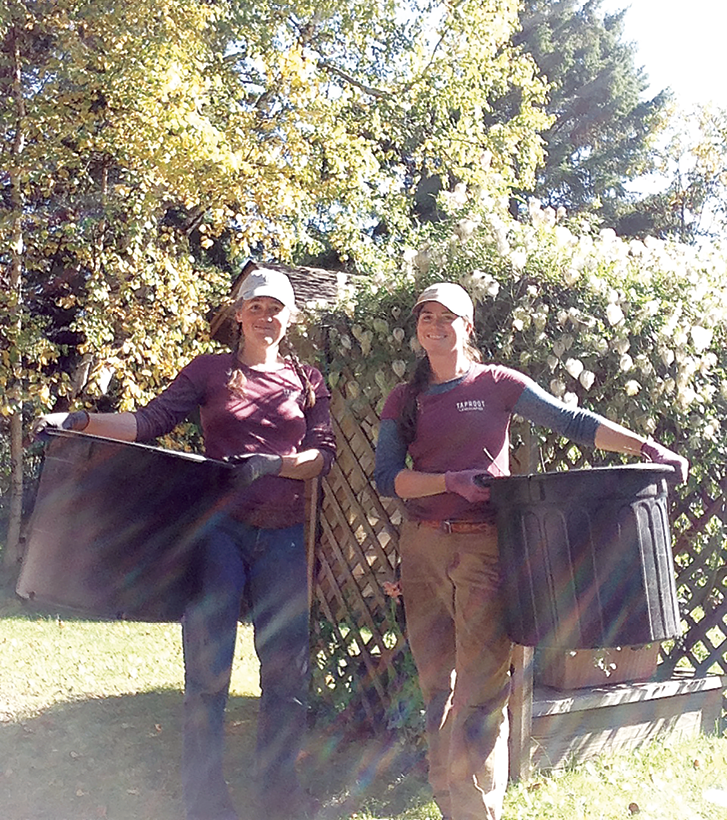March is here, and with it comes the official beginning of spring. While warm weather may still be a ways off in the Northern Wilds, this time of year many people start to think ahead and plan for gardens, tree planting and other landscaping to be done when the snow finally melts. While the North Shore is a uniquely beautiful region, the harsh winters, wildlife and soil types can pose a challenge for those looking to landscape their property. But unique challenges also yield unique rewards. Alisa Berns is the owner of Taproot Landscaping in Grand Marais. With 11 years of landscaping experience, she shares tips and ideas for homeowners looking to beautify their properties this summer.
While some may be eager to dive right into landscaping and planting their favorite plants, Berns says that the first step is to get to know your property, as different parcels of land can have vastly different characteristics even within the same region.
“As a landscaper, when I go to a site I get a lay of the land first,” Berns said. “Before starting a new project, homeowners should observe their property for a period of time to get to know it well. Dig around in the soil and see what kind of soil you have. What trees do you have? Is your property sloped or flat? Do you get standing water anywhere? Once you know what you’re working with you can make decisions based on what works well.”
For North Shore residents, an important consideration is your property’s microclimate: properties near Lake Superior are in growing zone 4, while properties farther inland are in zone 3. Plants that thrive near the lake may struggle farther inland, and vice versa.
After observing the land, the next step is to pick plants. One goal is to cultivate a wide variety of plants that bloom at different times of the year, creating a garden that not only looks beautiful from spring through autumn but also offers several months of food for pollinators. And unless you are an expert gardener, choose plants that are low-maintenance. If a plant is in the right place it should not need much pampering.

“Keep in mind that low-maintenance is not no-maintenance,” Berns said. “The forest always wants to fill back in, and no matter what you plant, you have to be willing to weed and do other upkeep. Certain plants are easier than others, but there’s no such thing as a garden you can plant and forget about.”
Apart from maintenance, Berns also urges homeowners to consider the importance of habitat gardening, and keeping wildlife in mind when designing your landscaping. Each garden has the potential to be its own ecosystem, with blossoming plants that provide food for pollinators, and rocks, driftwood or fallen trees that provide shelter and attract insects and birds.
“It’s important to remember that your property is not an island,” Berns said. “It’s a part of something bigger, part of the larger regional ecosystem.”
While homeowners may want to attract pollinators and birds, attracting other animals—like deer—can be a nuisance. Although articles circulate online touting lists of deer-resistant plants, Berns said it is important to know that “deer-free” is a myth, and left unprotected, deer will try any plant.
Despite being adventurous eaters, there are some tactics that work to deter deer. As deer have very good noses, Berns recommends using a spray like Plantskydd which smells bad to them, and to spray it every six weeks on your plants during the growing season. In the winter months, when snow-cover makes food scarce, deer will often turn to eating trees and shrubs. Winter fencing protects small trees and shrubs that are vulnerable to deer decimation. Deer are creatures of habit, and by fencing off food sources in the winter and making your garden smell bad in the summer, deer will begin to establish their regular routes away from your property to look for food elsewhere.
Finally, homeowners interested in landscaping should get familiar with native plants and keep an eye out for invasive species. Construction sites, with disturbances to the land and construction fill brought in from far away, are perfect places for invasive plants to grow. Invasive plant growth can be mitigated by smothering disturbed land with plastic for a season, and then working in topsoil and compost the next season. From there, native seed mixes can be planted to promote new growth.
Whatever you decide to plant, Berns said it is important to approach gardening with patience and a willingness to learn.
“A lot of gardening knowledge comes from failure. You’ll try something and it will fail, but you’ll start to grow an intuition of what works and what doesn’t. Be willing to tinker with and move things, and have the curiosity to investigate why something does or doesn’t work,” says Berns.
For those looking to learn more about landscaping and gardening, local UMN Extension offices provide many helpful tips and resources. More information about native plants can be found through the Minnesota DNR Native Plant Encyclopedia, available for free online through the MN DNR website.

